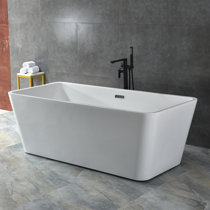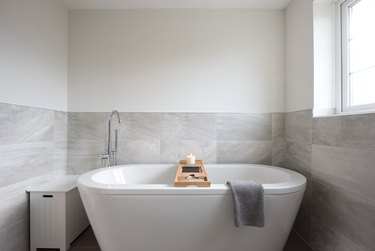Getting Familiar with Plumbing: Before Installing a Bathtub
Getting Familiar with Plumbing: Before Installing a Bathtub
Blog Article
How do you really feel in relation to A Step-by-Step Guide to Installing a Bathtub?

Installing a bathtub isn't precisely brain surgery, yet it does need solid plumbing, woodworking, and occasionally, tiling skills. Replacing an old bath tub with a brand-new one is additionally a moderately challenging task. If the old bathtub is easily obtainable, the project can move rapidly; if you need to open a wall surface to remove the old bathtub and place the brand-new bath tub, the task is a lot harder. In either case, the task is within a residence handyman's skills, although you will require a helper to vacate the old tub and embeded in the brand-new one. Ensure you have actually qualified yourself for the work and are comfortable attempting it. Rather than employing a contractor to take over a halfway-completed task, it is much better to take into consideration employing one before you start. Chances are you may need a specialist plumber to make tube links.
This article will certainly help you install a new tub in your restroom if you have already gotten a brand-new bathtub and also don't require to transform the arrangement of your previous water supply pipes.
Your devices as well as product list must comprise the following:
Removing Old Taps
If you need to change old taps with new ones as a part of your installation, then the first thing you should do is separate the water system. After doing so, activate the taps to drain any type of water continuing to be in the system. The procedure of removing the existing taps can be quite problematic because of the restricted accessibility that is frequently the instance.
Make use of a container wrench (crowsfoot spanner) or a faucet device to reverse the nut that links the supply pipelines to the taps. Have a cloth prepared for the remaining water that will certainly originate from the pipes. Once the supply pipes have actually been eliminated, make use of the exact same tool to loosen up the nut that holds the faucets onto the bath/basin. You will certainly require to stop the solitary taps from turning throughout this process. As soon as the faucets have actually been gotten rid of, the holes in the bath/basin will certainly need to be cleansed of any kind of old sealing substance.
Before moving on to fit the new taps, compare the pipe connections on the old taps to the brand-new taps. If the old taps are longer than the brand-new faucets, then a shank adapter is required for the new taps to fit.
Fitting New Touches
If the tails of the brand-new faucets are plastic, then you will certainly require a plastic port to stop damage to the thread. One end of the adapter fits on the plastic tail of the faucet and the various other end offers a link to the current supply pipes.
If you need to fit a monobloc, then you will certainly require reducing couplers, which links the 10mm pipe of the monobloc to the typical 15mm supply pipe.
Next, position the tap in the placing hole in the bath/basin ensuring that the washing machines are in place between the faucet and the sink. Protect the faucet in place with the manufacturer supplied backnut. When the faucet is safely in place, the supply pipes can be attached to the tails of the taps. The faucets can either be attached by utilizing corrugated copper piping or with regular tap adapters. The former type should be linked to the tap finishes first, tightening up only by hand. The supply pipes can later be attached to the various other end. Tighten up both ends with a spanner after both ends have been linked.
Setting up the Bathtub
Utilizing the two wooden boards under its feet, position the tub in the required placement. The wooden boards are handy in equally spreading the weight of the tub over the location of the boards instead of concentrating all the weight onto 4 small factors.
The next goal is to make certain that the tub is leveled all round. This can be attained by checking the spirit level and adjusting the feet on the bath tub until the level reads level.
To install faucets, fit the bottom of the furthest adaptable faucet adapter to the ideal supply pipe by making a compression join; after that do the very same for the various other tap.
Activate the water supply and also inspect all joints and new pipework for leaks and also tighten them if essential. Fill the tub as well as additionally check the overflow outlet and the normal outlet for leaks.
Lastly, fix the bathroom paneling as explained in the producer's instruction manual. Tiling and securing around the bath tub should wait up until the bathtub has been made use of a minimum of once as this will certainly resolve it right into its last position.
Getting ready for the Installment
First of all, the sustaining framework provided with the bathroom ought to be fitted (if needed) according to the supplier's directions. Next, fit the faucets or mixer to the bathtub. When suitable the tap block, it is very important to see to it that if the tap comes with a plastic washer, it is fitted in between the bathroom and the faucets. On a plastic bath, it is also reasonable to fit a supporting plate under the faucets device to prevent strain on the bathtub.
Fit the flexible faucet connectors to the bottom of the two faucets making use of 2 nuts and also olives (sometimes provided with the tub). Fit the plug-hole outlet by smearing mastic filler round the sink outlet hole, and afterwards pass the outlet with the hole in the bath. Use the nut supplied by the supplier to fit the plug-hole. Take a look at the plug-hole outlet for an inlet on the side for the overflow pipe.
Next, fit the end of the flexible overflow pipeline to the overflow electrical outlet. Afterwards, screw the pipeline to the overflow face which must be fitted inside the bath. Ensure you use all of the supplied washing machines.
Connect the trap to the bottom of the waste outlet on the bath tub by winding the string of the waste electrical outlet with silicone mastic or PTFE tape, and also screw on the catch to the electrical outlet. Attach all-time low of the overflow tube in a similar manner.The bathroom ought to currently prepare to be fitted in its last placement.
Tiling Around the Tub
In the area where the bath satisfies the ceramic tile, it is essential to seal the accompanies a silicone rubber caulking. This is important as the fitting can move enough to split an inflexible seal, creating the water to pass through the wall surface in between the bathroom as well as the tiling, bring about difficulties with wetness as well as feasible leakages to the ceiling below.
You can pick from a selection of coloured sealers to blend in your fixtures and also installations. They are offered in tubes and also cartridges, as well as are capable of sealing gaps as much as a size of 3mm (1/8 inch). If you have a larger void to fill, you can load it with spins of drenched newspaper or soft rope. Bear in mind to always fill up the bath tub with water prior to sealing, to permit the movement experienced when the tub is in use. The sealant can break relatively early if you do not consider this activity before sealing.
Additionally, ceramic coving or quadrant floor tiles can be utilized to edge the bathroom or shower tray. Plastic strips of coving, which are easy to use as well as cut to dimension, are additionally quickly available on the market. It is a good idea to fit the floor tiles using waterproof or water-proof adhesive and grout.
Bathtub Installation
How Important Is A Bathtub To Your Home?
High-quality baths, showers, and other bathroom updates are necessary when considering a smart investment in your home. It’s a room that you go to every day and one that is constantly being used by guests.The bathroom is one of the top trafficked rooms in a home and also one of the most valuable in terms of home resale.
Install Piping Before Tub
You will be using your existing drain and waste vent system, but pipes required include the hot and cold water supply lines and a pipe leading to a shower head. A mixing valve and shower head are also needed. Air chambers may be required.
Position the Tub
Lower the tub into place so that the continuous flange fits against the wall studs and rests on 1’x4' or 2’x4' supports. Anchor the tub to the enclosure with nails or screws inserted through the flanges into the studs.
NOTE: Remember, bathtubs and shower stalls may require support framing. A bathtub filled with water is extremely heavy, so check building codes and framing support before installing the tub.
Assemble Drain Connections
Assemble the bathtub drain connections by connecting the tub overflow with the tub drain above the trap, not beyond it. The trap will have a compression fitting that screws over the arm of the overflow assembly.
Place a Pipe For the Shower Head
First, locate a brass female threaded winged fitting and attach it to a framing support via a screw or a nail. Then run a pipe up the wall for the shower head. Sweat or solder the other side of the brass fitting to the top of the pipe.
Attaching Hot and Cold Water Lines
Attach your water lines for both hot and cold by sweating these directly into the hot and cold ports of the mixing valve. The mixing valve will be how water enters the tub’s system, not by the pipes themselves.
Install the Spout
Extend a piece of 1/2 inch pipe, or whichever length is specified in the manufacturer’s instructions, for the tub spout. Sweat on a male threaded fitting at the end of the pipe or use a brass nipple of the proper length and a 1/2 inch cap.
NOTE: At this point you should have your rough-in plumbing work inspected before proceeding further.
Check For Leaks
Restore the water pressure and check the drain connection and the supply pipes for any sign of leaking.
estore the Bathroom Wall
Replace the wall with moisture-resistant drywall as a base for your wall covering. Seal the joints between the wall and your new tub with silicone caulk as protection against water seepage.
https://www.berkeys.com/2016/12/02/bathtub-installation-dallas/

As a fervent reader about Installing A Bathtub, I thought sharing that piece of content was a great idea. If you enjoyed reading our blog posting please be sure to pass it around. Thank you for going through it.
Top Article Report this page